Welding - Personal Protective Equipment and Clothing
On this page
- What type of PPE is available when welding?
- Why is eye protection important?
- What type of eye and face protection is appropriate for my welding task?
- What are the various components of welding hand shields and helmets?
- What else should you know about eye protection?
- What should you know about filter shade selection?
- Can you wear contact lenses when welding?
- What measures can protect skin from welding radiation?
- What should you know about using respirators when welding?
- What are some tips to know when using protective clothing?
What type of PPE is available when welding?
Back to topThe chart below summarizes the types of personal protective equipment that can be used when welding. Personal protective equipment and clothing may be needed for the welder, welding personnel (operators, helpers, managers, supervisors), and any person nearby.
| Welding - Personal Protective Equipment | |||
|---|---|---|---|
| Body Part | Equipment | Illustration | Reason |
| Eyes and face | Welding helmet, hand shield, and goggles (or safety glasses with side shields) | 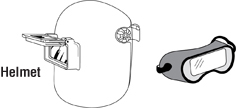 | Protects from:
Wear flame resistant head coverings under the helmet where appropriate |
| Lungs (breathing) | Respirators | 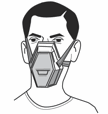 | Protects against:
|
| Exposed skin (other than feet, hands, and head) | Flame resistant clothing and aprons | 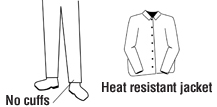 | Protects against:
Notes: pants should not have cuffs, shirts should have flaps over pockets or be taped closed |
| Ears - hearing | Ear muffs, ear plugs |  | Protects against:
Use flame resistant ear muffs where sparks or splatter may enter the ear, rather than plugs. |
| Feet and hands | Electric-shock and flame-resistant boots, flame-resistent gauntlet gloves | 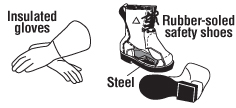 | Protects against:
|
Why is eye protection important?
Back to topEye injury can occur from the intense light and radiation that a welding arc can produce. Eye injury can also occur from hot slag and other metal debris that can fly off from the weld during cooling, chipping, or grinding.
- Welders, welding personnel (operators, helpers, managers, supervisors), and non-welding personnel must protect their eyes and face by wearing appropriate eye and face protection to protect against radiation and weld splatter.
- Protect your eyes from welding light by wearing a welder's helmet or hand shields fitted with a filter shade that is suitable for the type of welding present. Welding personnel and others observing the arc should also wear appropriate helmets or hand shields with filter lenses.
- ALWAYS wear goggles or safety glasses with side shields when welding or assisting a welder, even when other eye and face protection is also being used.
The exact type of protection required will depend on the type of welding being conducted.
What type of eye and face protection is appropriate for my welding task?
Back to topThe various types of eye protection are broken down into classes in the CSA standard Z94.3-20 "Eye and face protectors”. Each class is designed for a specific use. Eye and face protectors should have distinctive markings to identify the manufacturer and their class. Classifications of common protectors for welding operations are listed below:
- Class 2C – direct / non-ventilated goggles with non-ionizing radiation protection
- Class 3 – welding helmets
- Class 4 - welding hand shields
- Class 6 – face shields for non-ionizing radiation protection
- Class 7 – respirator facepiece for non-ionizing radiation protection
The following operations require full face protection by using either a welding helmet or a hand shield:
- arc welding,
- plasma arc cutting, gouging or welding, and
- air carbon arc cutting.
For gas cutting, welding, or brazing, the intensity of the light is much less than from arc welding, cutting or gouging processes. Lighter shade filter lenses can be used with goggles in place of a helmet.
More information can be found in the OSH Answers on Eye and Face Protectors.
What are the various components of welding hand shields and helmets?
Back to topHand shields or helmets provide eye protection by using an assembly of components:
- Helmet shell - must be opaque to light (not let light through) and resistant to impact, heat and electricity.
- The outer cover plate is made of polycarbonate plastic, which protects against radiation, impact, and scratches.
- A filter lens made of glass containing a filler, which reduces the amount of light passing through to the eyes. Filters are available in different shade numbers ranging from 2 to 14. The higher the number, the darker the filter and the less light passes through the lens.
- A clear retainer lens made of plastic prevents any broken pieces of the filter lens from reaching the eye.
- A gasket made of heat-insulating material between the cover lens and the filter lens protects the lens from sudden heat changes, which could cause it to break. In some models, the heat insulation is provided by the frame mount instead of a separate gasket.
Helmets and hand shields should be made of a material that:
- is a thermal insulator
- is an electrical insulator
- is not combustible or is self-extinguishing
- is able to be disinfected
- will not discolour, corrode or irritate the skin
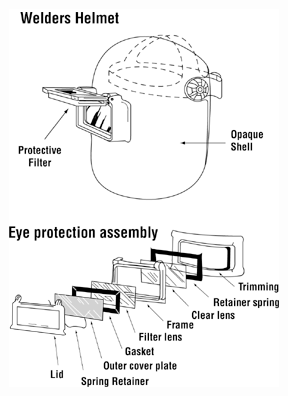
What else should you know about eye protection?
Back to top- Choose a tight-fitting helmet to help reduce light reflection into the helmet through the space between the shell and the head.
- Wear the helmet correctly. Do not use it as a hand shield.
- Protect the shade lens from impact and sudden temperature changes that could cause it to crack.
- Use a cover lens to protect the filter shade lens. Replace the cover lens if it gets scratched or hazy.
- Make sure to replace the gasket periodically if your helmet uses one.
- Replace the clear retaining lens to protect your eyes from broken pieces.
- Clean lenses as needed.
- Replace and discard pitted, cracked or damaged lenses.
What should you know about filter shade selection?
Back to topFor arc welding, the correct filter shade is selected according to the welding process, wire diameter, and operating current. The table below gives the correct shade numbers for different situations.
- ALWAYS use suggested shade numbers instead of minimum shade numbers. The values below are samples from CSA Standard W117.2-19 (R2023) Safety in welding, cutting and allied processes. Other processes are listed in the Standard.
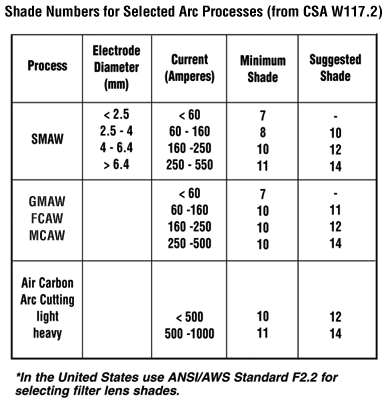
- Provide additional task lighting that suits welders' needs.
- Use the same shade as the welder's if you are directly observing the welding arc.
- Do not use gas welding goggles for arc welding.
- Do not substitute modified glasses, sunglasses, smoked plastic or other materials for proper welding lenses.
The recommended shade numbers for oxygen cutting are shown in the table below.
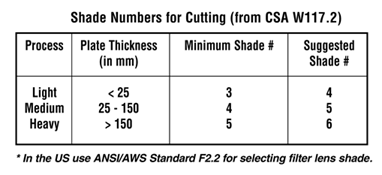
Can you wear contact lenses when welding?
Back to topThe CSA Standard W117.2:19 (R2023) states that contact lenses should not be worn by welders and welding personnel because foreign bodies (objects) in the eye can cause excessive irritation. Contact lenses do not provide protection from ultraviolet radiation and flying objects. All workers in proximity to welding procedures must wear appropriate eye protection according to the circumstances. The OSH Answers document Contact Lenses at Work discusses how dust particles or chemicals can irritate the eyes.
Note that in Canada, Prince Edward Island's Occupational Health and Safety Act General Regulations Section 45.11 specifically bans wearing contact lenses while welding.
What measures can protect skin from welding radiation?
Back to topProtective clothing should protect the worker from ultraviolet radiation (UV), sparks, and molten metal.
- Wear tightly woven work-weight fabrics to keep UV radiation from reaching your skin.
- Button up your shirt to protect the skin on the throat and neck.
- Wear long sleeves and pant legs.
- Cover your head with a flame-resistant cap to protect the scalp from UV radiation.
- Protect the back of your head by using a hood.
- Protect your face from UV radiation by wearing a tight-fitting, opaque welder's helmet.
- Make sure that all fabric garments are resistant to sparks, heat and flame. Keep the fabrics clean and free of combustible materials that could be ignited by a spark.
What should you know about using respirators when welding?
Back to topRespiratory protection is needed when ventilation is not sufficient to remove welding fumes or when there is a risk of oxygen deficiency. Select and use respirators in compliance with applicable regulations. Seek expert advice, conduct a hazard assessment, and initiate an appropriate respiratory protection program.
For more information on selecting the appropriate respirators, see the OSH Answers on Respirator Selection.
The process of selecting appropriate respiratory protection is also outlined in CSA standard Z94.4 and ANSI (American National Standards Institute) standard Z88.2 "Respiratory Protection".
What are some tips to know when using protective clothing?
Back to topDO
- Wear clothing made from heavyweight, tightly woven, 100% wool or cotton to protect from UV radiation, hot metal, sparks and open flames.
- Keep clothing clean and free of oils, greases and combustible contaminants.
- Launder flame-retardant fabrics according to the manufacturer's instructions. Some products, such as chlorine bleach or hydrogen peroxide, may damage the fabric or its properties.
- Wear long-sleeved shirts with buttoned cuffs and a collar to protect the neck. Dark colours prevent light reflection.
- Tape shirt pockets closed to keep sparks or hot metal from entering, or keep them covered with flaps.
- Pant legs must not have cuffs. Cuffs can collect sparks.
- Pants must cover over the tops of the boots.
- Choose a jacket or top that is long enough to overlap with the pants when the arms are stretched out so that there is no gap between the clothing.
- Repair all frayed edges, tears or holes in clothing.
- Wear high-top boots fully laced to prevent sparks from entering into the boots.
- Use flame-resistant boot protectors or spats strapped around the pant legs and boot tops to prevent sparks from bouncing in the top of the boots.
- Remove all ignition sources such as matches and butane lighters from pockets. Hot welding sparks may light the matches or ignite leaking lighter fuel.
- Wear gauntlet-type cuff leather gloves or protective sleeves of similar material to protect wrists and forearms. Leather is a good electrical insulator if kept dry.
- Using a shield can help keep any spark spray away from your clothing.
- Wear leather aprons to protect your chest and lap from sparks when standing or sitting.
- Wear layers of clothing. To prevent sweating, avoid overdressing in cold weather. Sweaty clothes cause rapid heat loss. Leather welding jackets are not very breathable and can make you sweat if you are overdressed.
- Wear a flame-resistant skull cap or balaclava hood under your helmet to protect your head from burns and UV radiation.
DO NOT
- Do not wear rings or other jewellery.
- Do not wear clothing made from synthetic or synthetic blends. The synthetic fabric can burn vigorously, melt and produce bad skin burns.
- Fact sheet last revised: 2025-10-15

